Input interpretation

bismuth (chemical element) | hafnium (chemical element) | iridium (chemical element)
Periodic table location
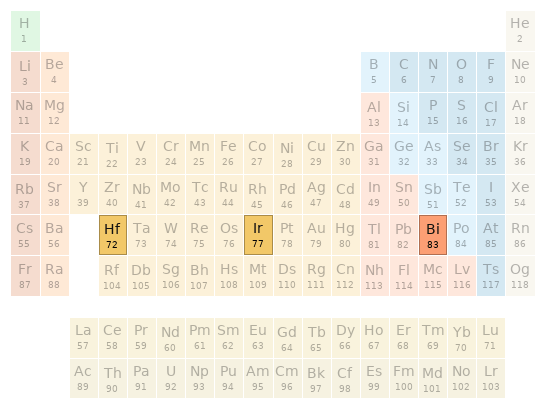
Periodic table location
Images
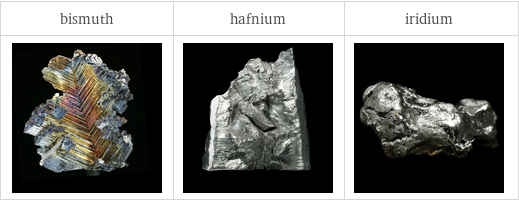
Images
Basic elemental properties
![| bismuth | hafnium | iridium atomic symbol | Bi | Hf | Ir atomic number | 83 | 72 | 77 short electronic configuration | [Xe]6s^24f^145d^106p^3 | [Xe]6s^24f^145d^2 | [Xe]6s^24f^145d^7 Aufbau diagram | 6p 5d 4f 6s | 5d 4f 6s | 5d 4f 6s block | p | d | d group | 15 | 4 | 9 period | 6 | 6 | 6 atomic mass | 208.9804 u | 178.49 u | 192.217 u half-life | 1.9×10^19 yr | (stable) | (stable)](../image_source/f1850c49364473e701724c11b0c2ca65.png)
| bismuth | hafnium | iridium atomic symbol | Bi | Hf | Ir atomic number | 83 | 72 | 77 short electronic configuration | [Xe]6s^24f^145d^106p^3 | [Xe]6s^24f^145d^2 | [Xe]6s^24f^145d^7 Aufbau diagram | 6p 5d 4f 6s | 5d 4f 6s | 5d 4f 6s block | p | d | d group | 15 | 4 | 9 period | 6 | 6 | 6 atomic mass | 208.9804 u | 178.49 u | 192.217 u half-life | 1.9×10^19 yr | (stable) | (stable)
Thermodynamic properties
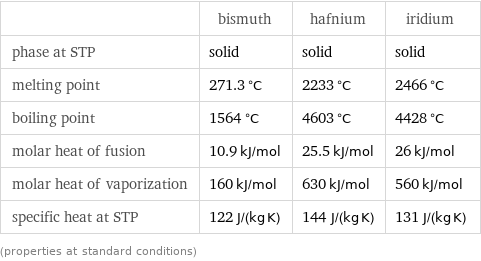
| bismuth | hafnium | iridium phase at STP | solid | solid | solid melting point | 271.3 °C | 2233 °C | 2466 °C boiling point | 1564 °C | 4603 °C | 4428 °C molar heat of fusion | 10.9 kJ/mol | 25.5 kJ/mol | 26 kJ/mol molar heat of vaporization | 160 kJ/mol | 630 kJ/mol | 560 kJ/mol specific heat at STP | 122 J/(kg K) | 144 J/(kg K) | 131 J/(kg K) (properties at standard conditions)
Material properties

| bismuth | hafnium | iridium density | 9.78 g/cm^3 | 13.31 g/cm^3 | 22.56 g/cm^3 liquid density | 10.05 g/cm^3 | 12 g/cm^3 | 19 g/cm^3 molar volume | 21.37 cm^3/mol | 13.41 cm^3/mol | 8.52 cm^3/mol Mohs hardness | 2.25 (between gypsum and calcite) | 5.5 (between apatite and microcline) | 6.5 (between microcline and quartz) Vickers hardness | | 1760 MPa | 1760 MPa Brinell hardness | 94.2 MPa | 1700 MPa | 1670 MPa bulk modulus | 31 GPa | 110 GPa | 320 GPa shear modulus | 12 GPa | 30 GPa | 210 GPa Young's modulus | 32 GPa | 78 GPa | 528 GPa Poisson ratio | 0.33 | 0.37 | 0.26 sound speed | 1790 m/s | 3010 m/s | 4825 m/s thermal expansion | 1.34×10^-5 K^(-1) | 5.9×10^-6 K^(-1) | 6.4×10^-6 K^(-1) thermal conductivity | 8 W/(m K) | 23 W/(m K) | 150 W/(m K) (properties at standard conditions)
Electromagnetic properties
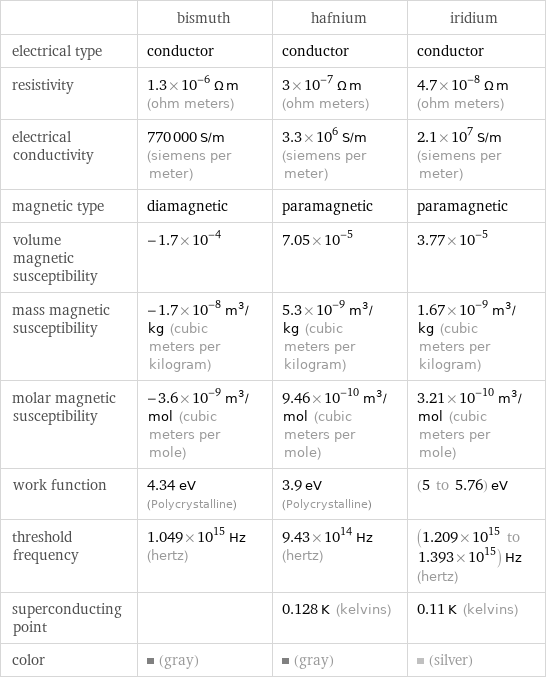
| bismuth | hafnium | iridium electrical type | conductor | conductor | conductor resistivity | 1.3×10^-6 Ω m (ohm meters) | 3×10^-7 Ω m (ohm meters) | 4.7×10^-8 Ω m (ohm meters) electrical conductivity | 770000 S/m (siemens per meter) | 3.3×10^6 S/m (siemens per meter) | 2.1×10^7 S/m (siemens per meter) magnetic type | diamagnetic | paramagnetic | paramagnetic volume magnetic susceptibility | -1.7×10^-4 | 7.05×10^-5 | 3.77×10^-5 mass magnetic susceptibility | -1.7×10^-8 m^3/kg (cubic meters per kilogram) | 5.3×10^-9 m^3/kg (cubic meters per kilogram) | 1.67×10^-9 m^3/kg (cubic meters per kilogram) molar magnetic susceptibility | -3.6×10^-9 m^3/mol (cubic meters per mole) | 9.46×10^-10 m^3/mol (cubic meters per mole) | 3.21×10^-10 m^3/mol (cubic meters per mole) work function | 4.34 eV (Polycrystalline) | 3.9 eV (Polycrystalline) | (5 to 5.76) eV threshold frequency | 1.049×10^15 Hz (hertz) | 9.43×10^14 Hz (hertz) | (1.209×10^15 to 1.393×10^15) Hz (hertz) superconducting point | | 0.128 K (kelvins) | 0.11 K (kelvins) color | (gray) | (gray) | (silver)
Reactivity
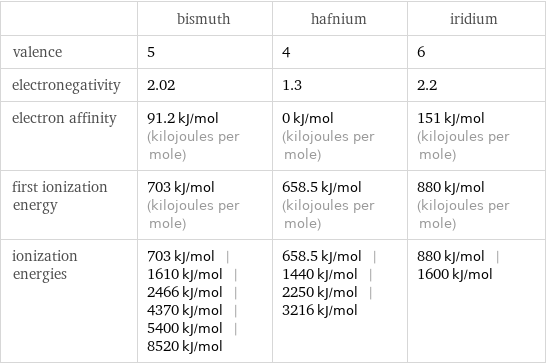
| bismuth | hafnium | iridium valence | 5 | 4 | 6 electronegativity | 2.02 | 1.3 | 2.2 electron affinity | 91.2 kJ/mol (kilojoules per mole) | 0 kJ/mol (kilojoules per mole) | 151 kJ/mol (kilojoules per mole) first ionization energy | 703 kJ/mol (kilojoules per mole) | 658.5 kJ/mol (kilojoules per mole) | 880 kJ/mol (kilojoules per mole) ionization energies | 703 kJ/mol | 1610 kJ/mol | 2466 kJ/mol | 4370 kJ/mol | 5400 kJ/mol | 8520 kJ/mol | 658.5 kJ/mol | 1440 kJ/mol | 2250 kJ/mol | 3216 kJ/mol | 880 kJ/mol | 1600 kJ/mol
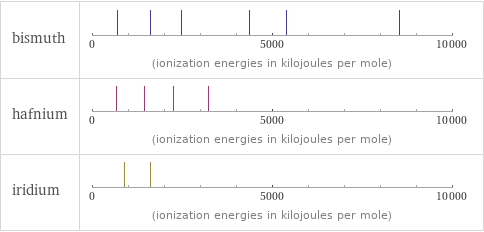
Reactivity
Atomic properties
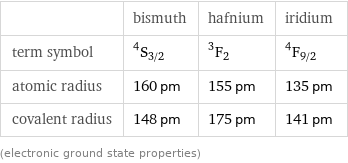
| bismuth | hafnium | iridium term symbol | ^4S_(3/2) | ^3F_2 | ^4F_(9/2) atomic radius | 160 pm | 155 pm | 135 pm covalent radius | 148 pm | 175 pm | 141 pm (electronic ground state properties)
Abundances
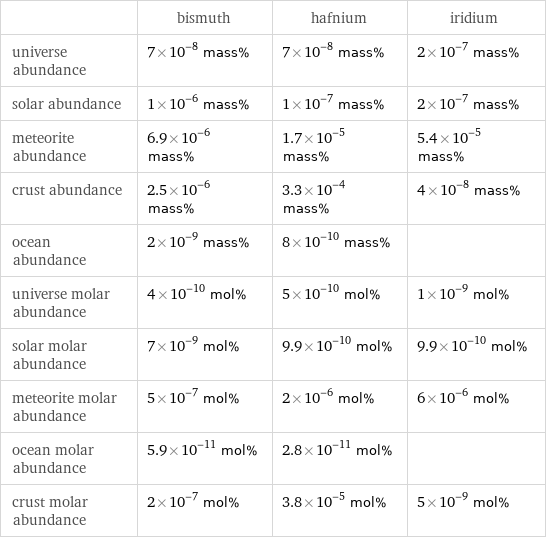
| bismuth | hafnium | iridium universe abundance | 7×10^-8 mass% | 7×10^-8 mass% | 2×10^-7 mass% solar abundance | 1×10^-6 mass% | 1×10^-7 mass% | 2×10^-7 mass% meteorite abundance | 6.9×10^-6 mass% | 1.7×10^-5 mass% | 5.4×10^-5 mass% crust abundance | 2.5×10^-6 mass% | 3.3×10^-4 mass% | 4×10^-8 mass% ocean abundance | 2×10^-9 mass% | 8×10^-10 mass% | universe molar abundance | 4×10^-10 mol% | 5×10^-10 mol% | 1×10^-9 mol% solar molar abundance | 7×10^-9 mol% | 9.9×10^-10 mol% | 9.9×10^-10 mol% meteorite molar abundance | 5×10^-7 mol% | 2×10^-6 mol% | 6×10^-6 mol% ocean molar abundance | 5.9×10^-11 mol% | 2.8×10^-11 mol% | crust molar abundance | 2×10^-7 mol% | 3.8×10^-5 mol% | 5×10^-9 mol%